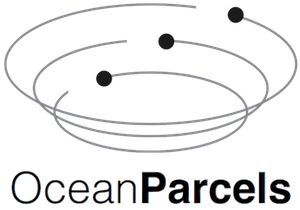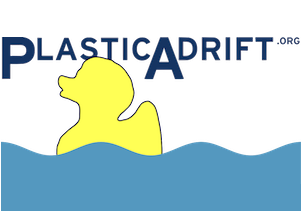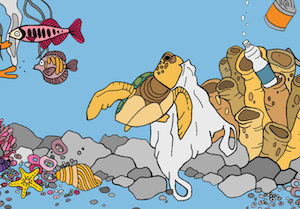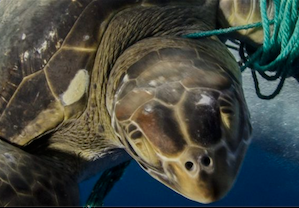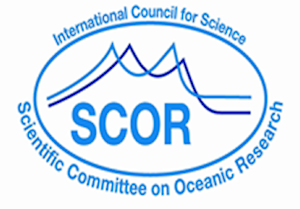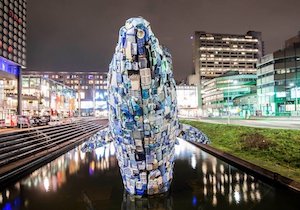Creating a 3D map of the plastic litter polluting our oceans
What is TOPIOS?
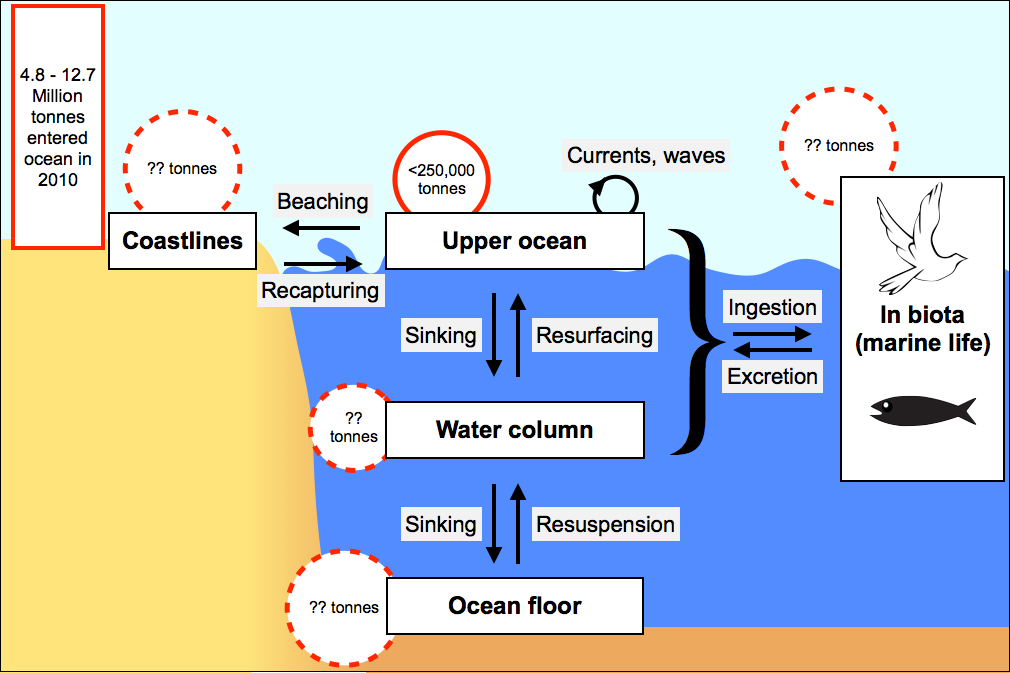
TOPIOS (Tracking Of Plastic In Our Seas) is a 5-year (2017-2022) research project, funded through a European Research Council Starting Grant project to Erik van Sebille.
Its goal is to vastly improve our understanding of the way plastic litter moves through our ocean.
To achieve this, we will develop an innovative, powerful and comprehensive model for tracking marine plastic through our ocean.
TOPIOS has been awarded the first ERC Public Engagement with Research Award for the '7 myths about the plastic soup' project.
Read the full abstractThe amount of plastic in our ocean is exponentially growing, with recent estimates of more than 5 million metric tonnes of plastic reaching the ocean each year. This plastic infiltrates the ocean food chain and thus poses a major threat to marine life. However, understanding of plastic movement and its budget in the ocean is inadequate to fully establish its environmental impact, prompting the EU and G7 to recently make marine litter a top science priority.
It is now recognised that the amount of plastic entering our ocean is several orders of magnitude larger than the estimates of floating plastic on the surface of the ocean. More than 99% of plastic within our ocean is therefore ‘missing’.
This TOPIOS project will make breakthroughs towards closing the plastic budget by creating a novel comprehensive modelling framework that tracks plastic movement through the ocean. Building on well-established previous work to follow generic water parcels through hydrodynamic ocean models, this project will modify these ‘virtual’ parcels to represent pieces of plastic by, for the first time, simulating fragmentation, sinking, beaching, wave-mixing and ingestion by biota.
The new parameterisations that underpin this modelling will be based on field data and new coastal flume wave tank lab experiments. The simulated plastic particles will be tracked within state-of-the-art hydrodynamic ocean models, in order to compute maps of pathways and transports around our oceans and on coastlines and in biota. This numerical modelling will be used to evaluate a broad suite of scenarios and test hypotheses, including where the risk to marine biota is greatest.
The results from this project will inform policymakers and the public on which countries, for example, are responsible for which part of the plastic problem, crucial for mitigation and legal frameworks. It will also inform engineers on where and how to best invest resources in mitigating the problem of plastic in our ocean.
Video by the European Research Council on the TOPIOS project
All team members during the project (2017-2022)
Jose M Alsina
Lecturer
Deborah Bassotto
MSc student
Tycho Bovenschen
MSc student
Mariana de Botton Falcon
MSc student
Laura Chow
MSc student
Philippe Delandmeter
Postdoctoral researcher
Ilja Deurloo
BSc student
Bram van Duinen
BSc student
Reint Fischer
Software support
Rebeca De La Fuente
Visiting PhD researcher
Laura Gomez Navarro
Postdoctoral researcher
Federica Guerrini
Visiting PhD researcher
Michal Janssen
BSc student
Cleo Jongedijk
PhD researcher
Mikael Kaandorp
PhD researcher
Christian Kehl
Postdoctoral researcher
Delphine Lobelle
Postdoctoral researcher
Maarten Muller
MSc student
Victor Onink
MSc student
Arianna Olivelli
MSc student
Erik van Sebille
Professor
Miriam Sterl
BSc student
Nicoleta Tsakali
BSc student
Aike Vonk
MSc student
Anneke Vries
MSc student
David Wichmann
PhD researcher
Peer-reviewed articles from TOPIOS
Global mass of buoyant marine plastics dominated by large long-lived debris
Kaandorp, MLA, D Lobelle, C Kehl, HA Dijkstra, E van Sebille (2023), Nature Geoscience, 16 689-694.[ Expand abstract ] [ Link to article - ]
Knowns and unknowns of plastic waste flows in the Netherlands
Lobelle, D, L Shen, B van Huet, T van Emmerik, MLA Kaandorp, G Iattoni, CP Baldé, KL Law, E van Sebille (2023), Waste Management & Research, in press.[ Expand abstract ] [ Link to article - ]
Rapid shipboard measurement of net-collected marine microplastic polymer types using near-infrared hyperspectral imaging
Beck, AJ, M Kaandorp, T Hamm, B Bogner, E Kossel, M Lenz, M Haeckel, EP Achterberg (2023), Analytical and Bioanalytical Chemistry, in press.[ Expand abstract ] [ Link to article - ]
Efficiently simulating Lagrangian particles in large-scale ocean flows — Data structures and their impact on geophysical applications
Kehl, C, PD Nooteboom, MLA Kaandorp, E van Sebille (2023), Computers and Geosciences, in press.[ Expand abstract ] [ Link to article - ]
Modeling carbon export mediated by biofouled microplastics in the Mediterranean Sea
Guerrini, F, D Lobelle, L Mari, R Casagrandi, E van Sebille (2023), Limnology and Oceanography, in press.[ Expand abstract ] [ Link to article - ]
The influence of particle size and fragmentation on large-scale microplastic transport in the Mediterranean Sea
Onink, V, MLA Kaandorp, E van Sebille, C Laufkötter (2022), Environmental Science & Technology, 56, 15528-15540.[ Expand abstract ] [ Link to article - ]
Five actionable pillars to engage the next generation of leaders in the co-design of transformative ocean solutions
Satterthwaite, EV, V Komyakova, NG Erazo, L Gammage, GA Juma, R Kelly, D Kleinman, D Lobelle, R Sapery James, N Binti Mohd Zanuri (2022), PLoS Biol, 20, e3001832.[ Expand abstract ] [ Link to article - ]
Perceptual multivariate visualisation of volumetric Lagrangian fluid-flow processes
Kehl, C, DMA Lobelle, E van Sebille (2022), Frontiers in Environmental Science, 10, 941910.[ Expand abstract ] [ Link to article - ]
Modeling submerged biofouled microplastics and their vertical trajectories
Fischer, R, D Lobelle, M Kooi, A Koelmans, V Onink, C Laufkötter, L Amaral-Zettler, A Yool, E van Sebille (2022), Biogeosciences, 19, 2211-2234.[ Expand abstract ] [ Link to article - ]
Plastic pollution in the Arctic
Bergmann, M, F Collard, J Fabres, GW Gabrielsen, JF Provencher, C Rochman, E van Sebille, MB Tekman (2022), Nature Reviews Earth & Environment.[ Expand abstract ] [ Link to article ]
Empirical Lagrangian parametrization for wind-driven mixing of buoyant particles at the ocean surface
Onink, V, E van Sebille, C Laufkötter (2022), Geoscientific Model Development, 15, 1995-2012.[ Expand abstract ] [ Link to article - ]
Using machine learning and beach cleanup data to explain litter quantities along the Dutch North Sea coast
Kaandorp MLA, SL Ypma, M Boonstra, HA Dijkstra, E van Sebille (2022), Ocean Science, 18, 269-293.[ Expand abstract ] [ Link to article - ]
Identifying Marine Sources of Beached Plastics through a Bayesian Framework: Application to Southwest Netherlands
Van Duinen, B, MLA Kaandorp, E van Sebille (2022), Geophysical Research Letters, 49, e2021GL097214.[ Expand abstract ] [ Link to article - ]
Practices, pitfalls and guidelines in visualising Lagrangian ocean analyses
Kehl, C, RPB Fischer, E van Sebille (2021), ISPRS Ann. Photogramm. Remote Sens. Spatial Inf. Sci., V-4-2021, 217-224[ Expand abstract ] [ Link to article- ]
An Inshore-Offshore Sorting System revealed from Global Classification of Ocean Litter
Morales-Caselles, C, J Viejo, E Martí, D González-Fernández, H Pragnell-Raasch, JI González-Gordillo, E Montero, GM Arroyo, G Hanke, VS Salvo, OC Basurko, N Mallos, L Lebreton, F Echevarría, T van Emmerik, CM Duarte, JA Gálvez, E van Sebille, F Galgani, CM García, PS Ross, A Bartual, C Ioakeimidis, G Markalain, A Isobe, A Cózar (2021), Nature Sustainability, 4, 484-493[ Expand abstract ] [ Link to article]
Global modeled sinking characteristics of biofouled microplastic
Lobelle, D, M Kooi, A Koelmans, C Laufkötter, C Jongedijk, C Kehl, E van Sebille (2021), Journal of Geophysical Research, 126, e2020JC017098[ Expand abstract ] [ Link to article - ]
Global simulations of marine plastic transport show plastic trapping in coastal zones
Onink, V, C Jongedijk, MJ Hoffman, E van Sebille, C Laufkötter (2021), Environmental Research Letters, 16, 064053[ Expand abstract ] [ Link to article - ]
Modelling size distributions of marine plastics under the influence of continuous cascading fragmentation
Kaandorp, MLA, HA Dijkstra, E van Sebille (2021), Environmental Research Letters, 16, 054075[ Expand abstract ] [ Link to article - ]
Sinking microplastics in the water column: simulations in the Mediterranean Sea
De la Fuente, R, G Drótos, E Hernández-García, C López, E van Sebille (2021), Ocean Science, 17, 431-453[ Expand abstract ] [ Link to article - ]
Ocean Surface Connectivity in the Arctic: Capabilities and Caveats of Community Detection in Lagrangian Flow Networks
Reijnders, D, EJ van Leeuwen, E van Sebille (2021), Journal of Geophysical Research, 126, e2020JC016416[ Expand abstract ] [ Link to article - ]
Ordering of trajectories reveals hierarchical finite-time coherent sets in Lagrangian particle data: detecting Agulhas rings in the South Atlantic Ocean
Wichmann, D, C Kehl, HA Dijkstra, E van Sebille (2021), Nonlinear Processes in Geophysics, 28, 43-59[ Expand abstract ] [ Link to article - ]
Laboratory measurements of the wave–induced motion of plastic particles: influence of wave period, plastic size and plastic density
Alsina, JM, C Jongedijk, E van Sebille (2020), Journal of Geophysical Research, 125, e2020JC016294[ Expand abstract ] [ Link to article - ]
The quest for seafloor macrolitter: A critical review of background knowledge, current methods and future prospects
Canals, M, C Pham, M Bergmann, L Gutow, G Hanke, E van Sebille, M Angiolillo, L Buhl-Mortensen, A Cau, C Ioakeimidis, U Kammann, L Lundsten, G Papatheodorou, A Purser, A Sanchez-Vidal, M Schulz, M Vinci, S Chiba, F Galgani, D Langenkämper, T Möller, TW Nattkemper, M Ruiz, S Suikkanen, L Woodall, E Fakiris, ME Molina Jack, A Giorgetti (2021), Environmental Research Letters, 16, 023001[ Expand abstract ] [ Link to article - ]
Detecting flow features in scarce trajectory data using networks derived from symbolic itineraries: an application to surface drifters in the North Atlantic
Wichmann, D, C Kehl, HA Dijkstra, E van Sebille (2020), Nonlinear Processes in Geophysics, 27, 501-518[ Expand abstract ] [ Link to article - ]
Beaching patterns of plastic debris along the Indian Ocean rim
Van der Mheen, M, E van Sebille, C Pattiaratchi (2020), Ocean Science, 16, 1317-1336[ Expand abstract ] [ Link to article - ]
Closing the Mediterranean Marine Floating Plastic Mass Budget: Inverse Modelling of Sources and Sinks
Kaandorp, MLA, HA Dijkstra, E van Sebille (2020), Environmental Science & Technology, 54, 11980–11989[ Expand abstract ] [ Link to article - ] [ Link to code on GitHub ] [ Link to website ]
Risks of floating microplastic in the global ocean
Everaert, G, M De Rijcke, B Lonneville, CR Janssen, T Backhaus, J Mees, E van Sebille, AA Koelmans, AI Catarino, M Vandegehuchte (2020), Environmental Pollution, 267, 115499[ Expand abstract ] [ Link to article - ]
The physical oceanography of the transport of floating marine debris
Van Sebille, E, S Aliani, KL Law, N Maximenko, JM Alsina, A Bagaev, M Bergmann, B Chapron, I Chubarenko, A Cózar, P Delandmeter, M Egger, B Fox-Kemper, SP Garaba, L Goddijn-Murphy, BD Hardesty, MJ Hoffman, A Isobe, CE Jongedijk, MLA Kaandorp, L Khatmullina, AA Koelmans, T Kukulka, C Laufkötter, L Lebreton, D Lobelle, C Maes, V Martinez-Vicente, MA Morales Maqueda, M Poulain-Zarcos, E Rodríguez, PG Ryan, AL Shanks, WJ Shim, G Suaria, M Thiel, TS van den Bremer, and D Wichmann (2020), Environmental Research Letters, 15, 023003[ Expand abstract ] [ Link to article - ]
Micro- and nanoplastics in Alpine snow – a new method for chemical identification and (semi)quantification in the nanogram range
Materić, D, A Kasper-Giebl, D Kau, M Anten, M Greilinger, E Ludewig, E van Sebille, T Röckmann, and R Holzinger (2020), Environmental Science & Technology, 54, 2353-2359[ Expand abstract ] [ Link to article - ]
Influence of barotropic tidal currents on transport and accumulation of floating microplastics in the global open ocean
Sterl, MF, P Delandmeter, and E van Sebille (2020), Journal of Geophysical Research, 125, e2019JC015583[ Expand abstract ] [ Link to article - ] [ Link to code on GitHub ]
Mixing of passive tracers at the ocean surface and its implications for plastic transport modelling
Wichmann, D, P Delandmeter, HA Dijkstra and E van Sebille (2019), Environmental Research Communications, 1, 115001[ Expand abstract ] [ Link to article - ] [ Link to code on GitHub ]
Measuring marine plastic debris from space: initial assessment of sampling requirements
Martínez-Vicente, V, J Clark, P Corradi, S Aliani, M Arias, M Bochow, G Bonnery, M Cole, A Cozar, R Donnelly, F Echevarria, F Galgani, SP Garaba, L Goddijn-Murphy, L Lebreton, HA Leslie, P Lindeque, N Maximenko, F Martin-Lauzer, D Moller, P Murphy, L Palombi, V Raimondi, J Reisser, L Romero, S Simis, S Sterckx, RC Thompson, KN Topouzelis, E van Sebille, JM Veiga, and D Vethaak (2019), Remote Sensing, 11, 2443[ Expand abstract ] [ Link to article - ]
Basin-scale sources and pathways of microplastic that ends up in the Galápagos Archipelago
van Sebille, E, P Delandmeter, J Schofield, BD Hardesty, J Jones, and A Donnelly (2019), Ocean Science, 15, 1341-1349[ Expand abstract ] [ Link to article - ] [ Link to code on GitHub ]
Influence of near‐surface currents on the global dispersal of marine microplastic
Wichmann, D, P Delandmeter, and E van Sebille (2019), Journal of Geophysical Research, 124, 6086-6096[ Expand abstract ] [ Link to article - ] [ Link to code on GitHub ]
Towards the Integrated Marine Debris Observing System
Maximenko, N, P Corradi, KL Law, E van Sebille, SP Garaba, RS Lampitt, F Galgani, V Martinez-Vicente, L Goddijn-Murphy, JM Veiga, RC Thompson, C Maes, D Moller, CR Löscher, AM Addamo, M Lamson, L Centurioni, N Posth, R Lumpkin, M Vinci, AM Martins, CD Pieper, A Isobe, G Hanke, M Edwards, IP Chubarenko, E Rodriguez, S Aliani, M Arias, GP Asner, A Brosich, JT Carlton, Y Chao, A-M Cook, A Cundy, TS Galloway, A Giorgetti, GJ Goni, Y Guichoux, BD Hardesty, N Holdsworth, L Lebreton, HA Leslie, I Macadam-Somer, T Mace, M Manuel, R Marsh, E Martinez, D Mayor, M Le Moigne, ME Molina Jack, MC Mowlem, RW Obbard, K Pabortsava, B Robberson, AE Rotaru, MT Spedicato, M Thiel, A Turra, and C Wilcox (2019), Frontiers in Marine Science, 6, 447[ Expand abstract ] [ Link to article - ]
The Parcels v2.0 Lagrangian framework: new field interpolation schemes
Delandmeter, P and E van Sebille (2019), Geoscientific Model Development, 12, 3571–3584[ Expand abstract ] [ Link to article - ] [ Link to code on GitHub ]
Role of Indian Ocean Dynamics on Accumulation of Buoyant Debris
van der Mheen, M, C Pattiaratchi, and E van Sebille (2019), Journal of Geophysical Research, 124, 2571-2590[ Expand abstract ] [ Link to article ]
Estimating the mass of chemicals associated with ocean plastic pollution to inform mitigation efforts
De Frond, HL, E van Sebille, JM Parnis, ML Diamond, N Mallos, T Kingsbury, and CM Rochman (2019), Integrated Environmental Assessment and Management, 15, 596-606.[ Expand abstract ] [ Link to article ]
Plastics in sea surface waters around the Antarctic Peninsula
Lacerda, ALF, LS Rodrigues, E van Sebille, FL Rodrigues, L Ribeiro, ER Secchi, F Kessler, and MC Proietti (2019), Scientific Reports, 9, 3977[ Expand abstract ] [ Link to article - ] [ Link to code on GitHub ]
The role of Ekman currents, geostrophy and Stokes drift in the accumulation of floating microplastic
Onink, V, D Wichmann, PB Delandmeter, and E van Sebille (2019), Journal of Geophysical Research, 124, 1474-1490[ Expand abstract ] [ Link to article - ] [ Link to code on GitHub ]
The true depth of the Mediterranean plastic problem: Extreme microplastic pollution on marine turtle nesting beaches in Cyprus
Duncan, EM, J Arrowsmith, C Bain, AC Broderick, J Lee, K Metcalfe, SK Pikesley, RTE Snape, E van Sebille, and BJ Godley (2018), Marine Pollution Bulletin, 136, 334-340[ Expand abstract ] [ Link to article ] [ Link to code on GitHub ]
The occurrence and degradation of aquatic plastic litter based on polymer physicochemical properties: a review
Bond, T, V Ferrandiz-Mas, M Felipe-Sotelo, and E van Sebille (2018), Critical Reviews in Environmental Science and Technology, 48, 685-722[ Expand abstract ] [ Link to article ]
Surface connectivity and inter-ocean exchanges from drifter-based transition matrices
McAdam, R and E van Sebille (2018), Journal of Geophysical Research, 123, 514-523[ Expand abstract ] [ Link to article - ]
Anticyclonic eddies increase accumulation of microplastic in the North Atlantic subtropical gyre
Brach, L, P Deixonne, MF Bernard, E Durand, MC Desjean, E Perez, E van Sebille, and A ter Halle (2018), Marine Pollution Bulletin, 126, 191-196[ Expand abstract ] [ Link to article ]
Lagrangian ocean analysis: fundamentals and practices
van Sebille, E, SM Griffies, R Abernathey, TP Adams, P Berloff, A Biastoch, B Blanke, EP Chassignet, Y Cheng, CJ Cotter, E Deleersnijder, K Döös, HF Drake, S Drijfhout, SF Gary, AW Heemink, J Kjellsson, IM Koszalka, M Lange, C Lique, GA MacGilchrist, R Marsh, CG Mayorga Adame, R McAdam, F Nencioli, CB Paris, MD Piggott, JA Polton, S Rühs, SHAM Shah, MD Thomas, J Wang, PJ Wolfram, L Zanna, and JD Zika (2018), Ocean Modeling, 121, 49-75[ Expand abstract ] [ Link to article - ]
Concept for a hyperspectral remote sensing algorithm for floating marine macro plastics
Goddijn-Murphy, L, S Peters, E van Sebille, N James, and S Gibb (2018), Marine Pollution Bulletin, 126, 255-262[ Expand abstract ] [ Link to article ]
All is not lost: Deriving a top-down mass budget of plastic at sea
Koelmans, AA, M Kooi, KL Law, and E van Sebille (2017), Environmental Research Letters, 12, 114028[ Expand abstract ] [ Link to article - ]
Parcels v0.9: prototyping a Lagrangian Ocean Analysis framework for the petascale age
Lange, M and E van Sebille (2017), Geoscientific Model Development, 10, 4175-4186[ Expand abstract ] [ Link to article - ]
Prevention through policy: Urban macroplastic leakages to the marine environment during extreme rainfall events
Axelsson, C and E van Sebille (2017), Marine Pollution Bulletin, 124, 211-227[ Expand abstract ] [ Link to article - ]
Media mentions in TOPIOS
Onderzoekers: Grootschalige plasticvervuiling op Noordpool
Reformatorisch Dagblad - 15 April 2022Overal op de noordpool vind je plastic – op de zeebodem, in het ijs, op de stranden
NRC - 8 April 202220 tot 80 kilo troep per kilometer strand: onderzoekers brengen aangespoeld afval in kaart
Parool & New Scientist - 18 March 2022Door dit onderzoek van Mikael weten we precies hoeveel plastic er langs onze kustlijn ligt
Algemeen Dagblad - 11 March 2022Dark Plastic | Waar is al dat plastic in de oceaan gebleven?
Plastic Soup Surfer | Podcast - 6 February 2022‘Je moet niet praten over plasticsoep maar over plasticbouillon’
New Scientist - 29 January 2022De wetenschap in 2022
NPO Radio1 Spraakmakers - 5 January 202299% of ocean plastic is missing
Vox.com podcast Unexplainable - 16 December 2021Ocean Garbage Patches Have a Microscopic Problem
Wall Street Journal video - 17 November 2021Why 99% of ocean plastic pollution is “missing”
Vox.com - 27 April 2021Geen plastic soep, maar zeeën van stofdraden
Trouw - 6 June 2020Oceaanwetenschappers roeren in troebele soep: miljarden kilo’s plastic ‘kwijt’
Algemeen Dagblad - 23 May 2020What happened to all the plastic we released into the oceans?
Physics World - 21 May 2020The search for the missing plastic
Physics World - 7 May 2020En värld som drunknar i sopor
Sveriges Radio - 4 Mar 2020Plasten inntar polene
Hold Norge Rent Magasinet - 19 Feb 2020The ocean plastic we see is 'the tip of the iceberg'. Where's the other 99%?
Guardian - 31 Dec 2019Why does the Arctic have more plastic than most places on Earth?
National Geographic - 30 Oct 2019Where Does All the Plastic Go?
The New Yorker - 16 Sep 2019De hoeveelheid plastic in zee is sinds 2000 aanzienlijk toegenomen; het meeste is afkomstig van visserij
Volkskrant (in Dutch) - 17 Apr 2019There is no garbage patch in the Southern Indian Ocean, so where is the rubbish?
ABC Australia - 17 Apr 2019Clues emerge in 'missing' ocean plastics conundrum
France24 - 9 Apr 2019Warum Plastikmüll eine Riesen-Chance für die Forschung ist
Welt (in German) - 2 Feb 2019With plastic waste reaching far isles, experts call for int'l countermeasure body
The Mainichi - 9 Jan 2019Dobberende My Little Pony's in Noordzee bieden kansen voor wetenschap
NPO Radio 1 (in Dutch) - 8 Jan 2019Hoe groot is de plastic soep precies?
NPO Radio 1 (in Dutch) - 4 Jan 2019The Riddle of the Roaming Plastics
Hakai Magazine - 4 Dec 2018Tracking the movement of all plastic litter in the ocean is crucial
EuroScientist - 8 Nov 2018Le nettoyage des plages, c’est bon pour le moral (et l’environnement)
Le Monde (in French) - 11 Aug 2018The fight against the Great Pacific garbage patch needs its own climate panel
NRC.nl - 28 Jun 2018Plastic pollution crisis: How waste ends up in our oceans
GlobalNews.ca - 17 Jun 2018Why tracking the movement of plastic litter in the oceans is crucial
Euractiv - 12 Jun 2018Sticky tape and simulations help assess microplastic risk
Horizon Magazine - 23 Apr 2018La contaminación asfixia a la economía
El País (in Spanish) - 14 Apr 201835 plastic containers go into the sea every hour
Kanaal Z - 12 Apr 2018Tons of plastic in the sea: 'There is still a lot that we do not know'
Standaard.be - 10 Apr 20188 million tonnes of plastics pour into the seas and oceans every year
Sega Daily Bulgaria - 10 Mar 2018The known unknowns of plastic pollution
The Economist - 3 Mar 2018The many dangers facing world oceans
The World Weekly - 21 Dec 2017What this toy from a 1958 packet of Sugar Puffs tells us about the catastrophe caused by plastic
Daily Mail - 19 Dec 2017Mountains of plastic from all over the globe are found on a Cornish beach
Daily Mail - 10 Nov 2017Forget diamonds – it’s plastic that is forever
ScienceNode - 4 Aug 2017De laatste grens: Kijken in de zeespiegel – het lot van de oceaan
Groene Amsterdammer (in Dutch) - 9 Aug 2017Researchers map plastic patch bigger than Greenland floating in the South Pacific
Stuff.co.nz - 23 Jul 2017A mission to the Pacific plastic patch
BBC - 16 Jul 2017Critics say plan for drifting ocean trash collectors is unmoored
Science - 11 May 2017Noordelijke IJszee vol plastic
NPO Radio 1 (in Dutch) - 23 Apr 2017A big patch of plastic garbage has been discovered in the Arctic
The Verge - 19 Apr 2017Dans l’Arctique aussi, les déchets plastiques s’accumulent
Le Monde (in French) - 19 Apr 2017El plástico que tiramos llega hasta el círculo polar
El País (in Spanish) - 19 Apr 2017TOPIOS would like to thank the erc=science² project at Science|Business for support with some of these media exposures.
